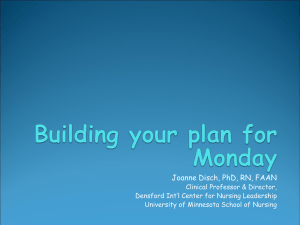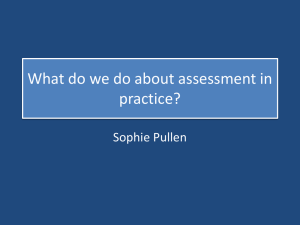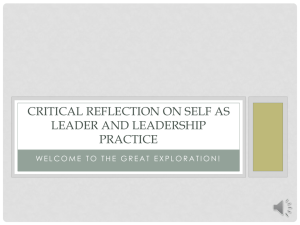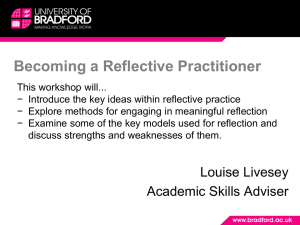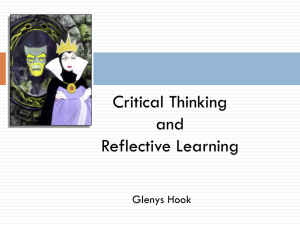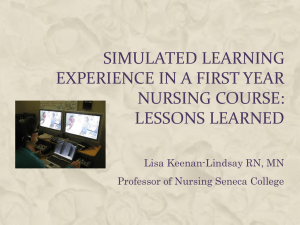reflective cycle
advertisement
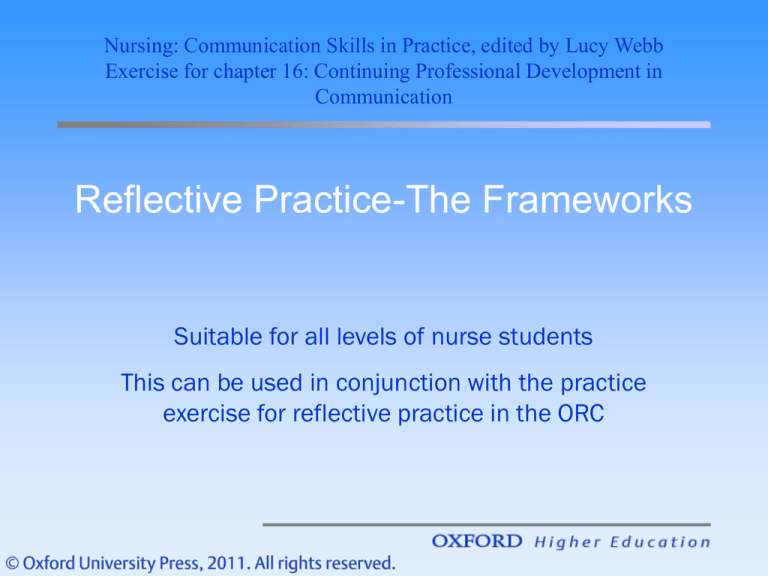
Nursing: Communication Skills in Practice, edited by Lucy Webb Exercise for chapter 16: Continuing Professional Development in Communication Reflective Practice-The Frameworks Suitable for all levels of nurse students This can be used in conjunction with the practice exercise for reflective practice in the ORC Introduction • Reflective practice is associated with learning from experience, and is viewed as an important strategy for health professionals who embrace life long learning • The act of reflection is seen as a way of promoting the development of autonomous, qualified and selfdirected professionals • Engaging in reflective practice is associated with the improvement of the quality of care, stimulating personal and professional growth and closing the gap between theory and practice. Introduction cont. • The process of reflective writing leads to more than just a gain in your knowledge; it should also challenge the concepts and theories by which you make sense of knowledge • When you reflect on a situation you do not simply see more, you see differently. This different way of viewing a situation is reflected in statements about a commitment to action Schon (1983) • The Ineffective • The Effective practitioner is confined reflective practitioner to repetitive and routine is able to recognise practice, neglecting and explore confusing opportunities to think or unique (positive or about what he/she is negative) events that doing occur during practice Reflective process • There are numerous frameworks for structuring the process of reflection. • All reflective models comprise of three fundamental processes: – Retrospection: thinking back on events – Self-evaluation: attending to feelings – Reorientation: re-evaluating experiences Models/Frameworks Gibbs Reflective Cycle • The Gibbs (1988) reflective cycle is considered fairly straightforward • It encourages a clear description of the situation, analysis of feelings, evaluation of the experience, analysis to make sense of the experience, conclusion where other options are considered and reflection upon experience to examine what you would do if the situation arose again Gibbs reflective cycle DESCRIPTION (What happened) Action Plan (If it arose again what would you do?) Feelings (What were you thinking + feeling?) Conclusion Evaluation (What was good and bad?) Description (What sense can you make of the situation) Stage 1: Description of the event • Describe in detail the event you are reflecting on • Include: where you were; who else was there; why you were there; what you were doing; what other people were doing; what the context of the event was; what happened; what your part was; what parts the other people played; what the result was Stage 2: Feelings • Try to recall and explore what was going on inside your head i.e. why does this event stick in your mind? • Include: how were you feeling when the event started; what you were thinking about at the time; how it made you feel; how other people made you feel; how you felt about the outcome of the event; what you think about it now Stage 3: Evaluation • Try to evaluate or make a judgement about what has happened. • Consider what was good about the experience and what was bad about the experience, or didn’t go so well Stage 4: Analysis • Break the event down into its component parts so they can be explored separately • You may need to ask more detailed questions about the answers to the last stage • Include: what went well; what you did well; what others did well; what went wrong or did not turn out how it should have done; the way you, or others, contributed to this Stage 5: Conclusion • This differs from the evaluation stage in that now you have explored the issue from different angles and have a lot of information to base your judgement • It is here that you are likely to develop insight into your own and other people’s behaviour in terms of how they contributed to the outcome of the event Conclusion cont. • Remember the purpose of reflection is to learn from an experience • Without the detailed analysis and honest exploration that occurs during all the previous stages, it is unlikely that all aspects of the event will be taken into account • Therefore valuable opportunities for learning can be missed • During this stage you should ask yourself what you could have done differently Stage 6: Action Plan • During this stage you should think about encountering the event again and plan what you would do – would you act differently or would you be likely to do the same? • Here the cycle is tentatively completed and suggests that should the event occur again it will be the focus of another reflective cycle Other models of reflection • There are other models of reflection and there are brief explanations for some in the next few slides – John’s model of reflection – The What? model of structured reflection by Driscoll John’s model of structured reflection • John’s model can be used as a guide for analysis of a critical incident or general reflection on experience. This would be useful for more complex decision making and analysis at levels 3 & 4 • He supports the need for the learner to work with a supervisor throughout their learning experience • He refers to this as guided reflection, and recommends that students use a structured diary John’s model of structured reflection cont. • John feels that through sharing reflections on learning experiences, greater understanding of those experiences can be achieved than by reflection as a lone exercise • John also uses Carper’s (1978) four patterns of knowing, aesthetics, personal, ethics and empirics adding a fifth pattern ‘reflexivity’ Driscoll’s ‘The What?’ model (2000) • A description of events (What? trigger questions) • An analysis of events (So What? trigger) • Proposed actions following events (Now What? trigger) Reminder - why we should reflect • Reduces the theory-practice gap – (Perkins 1996; Fonteyn & Cahill 1998; Getliffe 1996; Foster & Greenwood 1998; Smith 1998; Burton 2000; Carney 2000; Duke & Appleton 2000; Maudsley & Scrivens 2000b; Stewart & Richardson 2000; Koh 2002). • Encourages critical thinking ability – (Patton et al 1997; Durgahee 1998; Foster & Greenwood 1998; Burton 2000; Maudsley & Scrivens 2000b; Cotton 2001) • Helps practitioners to make more sense of difficult and complex practice – (Driscoll & Teh 2001) Reminder - why we should reflect cont. • Enhances personal development by leading to self-awareness – (Cotton 2001) • The focus of reflection is improvement in patient care therefore it helps to expand and develop clinical knowledge and skills – (Graham 2000; Platzer et al 2000; Driscoll & Teh 2001; Paget 2001) • Slows down activity thereby providing time to process material of learning and link it to previous ideas – (Moon 2002) Reminder - why we should reflect cont. • Enables greater ownership of the learning taking place – (Moon 2002) • Promotes optimum effectiveness and efficiency in an ever evolving and complex health care system through practitioners auditing their own practice – (Degazon & Lunney 1995; Carr 1996; Clark et al 1996; Durgahee 1996; Heath 1998; Hinett & Weeden 2000) • “Reminds qualified practitioners that there is no end point to learning about their everyday practice” – (Driscoll & Teh 2001: 98). Top tips for reflecting (Taylor 2000) • Be spontaneous – it is from the frank and honest self that important insights arise • Express yourself freely – you don’t need to observe the normal academic practices involved in writing • Remain open to ideas – early conclusions can inhibit further insights and solutions References and Bibliography Atkins, S., Murphy, K. (1993) Reflection: A Review of the Literature. Journal of Advanced Nursing , Vol.18 (8), pp.1188 – 1192 Bulman, C., Schutz, S. (2004) Reflective Practice in Nursing. 3rd ed. Oxford, Blackwell Publishing Burnard, P. (2002) Learning Human Skills: An Experiential and Reflective Guide for Nurses and Health Care Professionals. 4th ed. Oxford, Butterworth Heinemann Burton, A.J. (2000) Reflection: Nursing’s practice and education panacea?, Journal of Advanced Education, Vol. 31 (5) pp.1009-1017 Carney, M. (2000) The development of a model to manage change: reflection on a critical incident in a focus group setting. An innovative approach, Journal of Nursing Management, Vol. 8, pp.265-272 Carper, B.A. (1978) Fundamental patterns of knowing in nursing. Advances in Nursing Science-Practice Orientated Theory, Vol. 1 (1) pp.13-23 Carr, E. (1996) Reflecting on clinical practice: hectoring talk or reality? Journal of Clinical Nursing , Vol.5, pp. 289-295 Clark, B., James, C., Kelly, J. (1996) Reflective practice; reviewing the issues and refocusing the debate, International Journal of Nursing Studies, Vol. 33 (2) pp. 171-180. References and Bibliography cont. Cotton, A.H. (2001) Private thoughts in public spheres: issues in reflection and reflective practices in nursing, Journal of Advanced Nursing, Vol. 36 (4) pp. 512-519 Degazon, C.E., Lunney, M. (1995) Clinical journal: a tool to foster critical thinking for advanced levels of competence, Clinical Nurse Specialist , pp.270-274 Driscoll, J., Teh, B. (2001) The potential of reflective practice to develop individual orthopaedic nurse practitioners and their practice, Journal of Orthopaedic Nursing, Vol. 5, pp. 95-103 Duke, S., Appleton, J. (2000) The use of reflection in a palliative care programme: a quantitative study of the development of reflective skills over an academic year. Journal of Advanced Nursing Vol.32 (6) pp.1557-1568. Durgahee, T. (1996) Promoting reflection in post-graduate nursing: a theoretical model, Nurse Education Today, Vol. 16, pp.419-426 Durgahee, T. (1998) Facilitating reflection: from the sage on the stage to a guide on the side. Nurse Education Today Vol.18, pp.158-164 References and Bibliography cont. Fonteyn, M.E., Cahill, M. (1998) The use of clinical logs to improve nursing students’ metacognitions: a pilot study, Journal of Advanced Nursing , Vol.28 (1), pp. 149154. Foster, J. & Greenwood, J. (1998) Reflection: A challenging innovation for nurses, Contemporary Nurse , Vol.7, pp. 165-172. Getliffe , K.A. (1996) An examination of the use of reflection in the assessment of practice for undergraduate nursing students, International Journal of Nursing Studies , Vol.33 (4), pp. 361-374. Gibbs, G. (1988) Learning by Doing: A Guide to Teaching and Learning Methods. Oxford, Further Education Unit, Oxford Polytechnic. Graham, I.W. (2000) Reflective practice and its role in mental health nurses’ practice development: a year-long study. Journal of Psychiatric and Mental Health Nursing , Vol.7, pp.109-117 Heath, H. (1998) Paradigm dialogues and dogma: finding a place for research, nursing models and reflective practice, Journal of Advanced Nursing , Vol. 28 (2) pp.288-294 Hinett, K., Weeden, P. (2000) How am I doing?: developing critical self-reflection in trainee teachers. Quality in Higher Education, Vol. 6 (3) pp.245- 257 References and Bibliography cont. Jasper, M. (2003) Beginning Reflective Practice: Foundations in Nursing and Health, Cheltenham, Nelsons Thorsens Johns C (1999) Reflection as empowerment? Nursing Inquiry, Vol. 6 (4) pp.241 249 Johns, C. (2000) Becoming a Reflective Practitioner: A Reflective and Holistic Approach to Clinical Nursing, Practice Development and Clinical Supervision. Oxford, Blackwell Publishing. Johns, C. (2004) Becoming a reflective practitioner. 2nd edn. Oxford, Blackwell Publishing Johns, C. (2005) Transforming Nursing Through Reflective Practice. 2nd edn. Oxford, Blackwell Publishing. Koh, L.C. (2002) Practice-based teaching and nurse education, Nursing Standard Vol.16 (19) pp. 38-42, In- Maudsley, G. & Scrivens, J. (2000b) Promoting professional knowledge, experiential learning and critical thinking for medical students. Medical Education Vol.34, pp.535-544 Moon, J. (2002) PDP Working paper 4: Reflection in Higher Education Learning. Learning and Teaching Support Network Generic Centre http://www.ltsn.ac.uk/genericcentre/projects/pdp/working-papers/ References and Bibliography cont. Paget, T. (2001) Reflective practice and clinical outcomes: practitioners’ views on how reflective practice has influenced their clinical practice. Journal of Clinical Nursing , Vol.10, pp.204-214 Patton, J.G., Woods, S.J., Agarenzo, T., Brubaker, C., Metcalf, T., Sherrer, L. (1997) Enhancing the clinical practicum experience through journal writing. Journal of Nursing Education Vol.36 (5) pp. 238-240 Perkins, J. (1996) Reflective journals: suggestions for educators. Journal of Physical Therapy Education , Vol.10 (1) pp.8-13 Platzer, H., Blake, D., Ashford, D. (2000) Barriers to learning from reflection: a study of the use of groupwork with post-registration nurses, Journal of Advanced Nursing , Vol.31 (5) pp.1001-1008 Schon, D. (1983) The reflective practitioner: how professionals think in action, Basic Books: New York. Smith, A. (1998) Learning about reflection. Journal of Advanced Nursing Vol.28 (4) pp.891-898 Taylor, B. (2000) Reflective Practice: A Guide for Nurses and Midwives. Buckingham, Open University Press.

